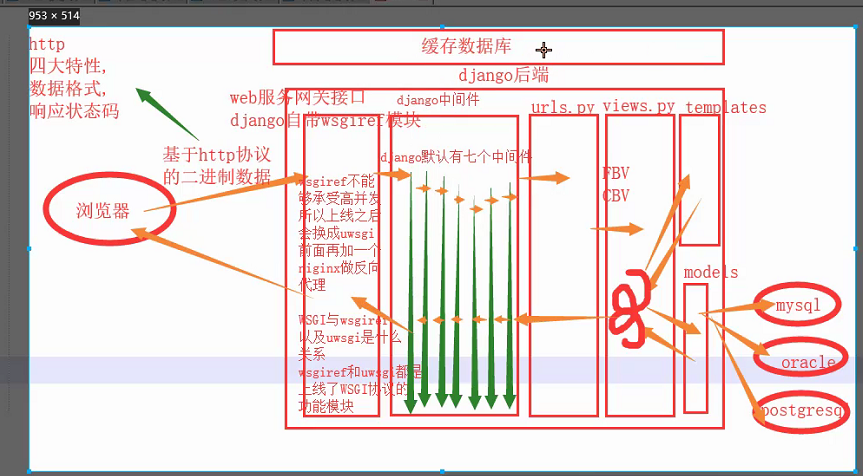1.中间键
2.csrf跨站请求伪造
3.装饰器相关
4.auth模块
5.settings 插拔式源码 拓展
1.中间键

中间件:(默认有七个)
通俗讲:django中间件类似于django的保安,来去都经过他;
大致流程:请求来时先经过中件才能到达django后端(urls,views,templates,models),
响应走时也要经过中间件才能到达web网关接口
作用:
1.网站全局的身份校验,访问频率限制,权限校验.....涉及全局,都可用到
2. django的中间件是所有web框架中做的最好的
django中间件中的五个自定义方法
*****
1.process_request()
规律:
1.请求来时,自上而下依次执行每个中间件里的process_request的方法;
2.如果这个方法里直接返回了HttpResponse对象,不会再往下执行;而是跳到同级别的 process_response
方法,直接往回走;
应用场景:访问频率限制,身份校验
2.prosess_response()
规律:
1.必须将形参response返回, 该形参是返回前端的数据
2.响应走时会自下而上的执行每一个中间件中的process_response方法
**
3.process_view(): 在url匹配成功之后,视图函数之前 触发
4.process_exception(): 视图函授出错之后触发,自行执行
5.process_template_response():
规律:
1.返回的HttpResponse对象中必须包含render属性才会触发,如下例:
def login(request):
print('我是谁?我从哪里来?')
def render():
return HttpResponse('6666')
OBJ= HttpResponse('我要到那里去?')
OBJ.render = render
return OBJ
注:1.写中间件中时,只要有response这个形参,那就返回response(给前端的信息)
自定义我们自己的中间键
1.要想自己写的中间件生效,必须先继承MiddlewareMiXin
2.注册中间件时,路径不要写错
2.csrf跨站请求伪造
csrf跨站请求伪造:
钓鱼网站: 制造一个更正常网站一模一样的网站,骗取用户输入信息,eg转账交易..
钓鱼原理: 在用户输入对方账户的input框中做些改动;比如这个input框 不设置name属性,
然后在内部隐藏那个一个已经写好有 name,value属性的input框
预防思路:给用户的form表单 中 放一个每次永远不会重复的随机字符串作为唯一标识,
验证通过再进行其他操作,未通过,返回一个403
随机字符串特点:
1.同一个浏览器每一次访问都不一样
2.不同浏览器 绝对不会重复
1. form表单发送 post请求时, 需要
{% csrf_token %}
2. ajax 发送post请求,避免csrf校验的方法
首先:{% csrf_token %}
其次:
1.利用标签查找获取该input框的键值信息
{'username':'xxx','csrfmiddlewaretoken':$('[name=csrfmiddlewaretoken]').val()}
2.直接写
{'username':'xxx','csrfmiddlewaretoken':'{{csrf_token}}'}
3.将获取随机键值对的方法弄到js文件中,用时导进去
相关代码:
function getCookie(name) {
var cookieValue = null;
if (document.cookie && document.cookie !== '') {
var cookies = document.cookie.split(';');
for (var i = 0; i < cookies.length; i++) {
var cookie = jQuery.trim(cookies[i]);
// Does this cookie string begin with the name we want?
if (cookie.substring(0, name.length + 1) === (name + '=')) {
cookieValue = decodeURIComponent(cookie.substring(name.length + 1));
break;
}
}
}
return cookieValue;
}
var csrftoken = getCookie('csrftoken');
function csrfSafeMethod(method) {
// these HTTP methods do not require CSRF protection
return (/^(GET|HEAD|OPTIONS|TRACE)$/.test(method));
}
$.ajaxSetup({
beforeSend: function (xhr, settings) {
if (!csrfSafeMethod(settings.type) && !this.crossDomain) {
xhr.setRequestHeader("X-CSRFToken", csrftoken);
}
}
});
3.装饰器相关
1 装饰器相关:
2 1.全局不校验csrf,有几个让校验 csrf_frotect
3 2.全局校验csrf,有几个不让校验 csrf_exempt
4 form django.utils.decorators import method_decorator
5 form django.views.decorators.csrf import csrf_exempt(不校验),csrf_frotect(校验)
6 给fbv装饰时正常,给cbv装饰时有以下两种情况发生
7 1.csrf_frotect 的 三种装饰方式
8 # 第一种方式
9 # @method_decorator(csrf_protect,name='post') # 有效的
10 class MyView(View):
11 # 第三种方式
12 # @method_decorator(csrf_protect)
13 def dispatch(self, request, *args, **kwargs):
14 res = super().dispatch(request, *args, **kwargs)
15 return res
16
17 def get(self,request):
18 return HttpResponse('get')
19 # 第二种方式
20 # @method_decorator(csrf_protect) # 有效的
21 def post(self,request):
22 return HttpResponse('post')
23
24 注: 三种方法可随意用其中的一种
25 2.csrf_exempt的两种装饰方式(只能给dispatch装) 特例
26 @method_decorator(csrf_exempt,name='dispatch') # 第二种可以不校验的方式
27 class MyView(View):
28 # @method_decorator(csrf_exempt) # 第一种可以不校验的方式
29 def dispatch(self, request, *args, **kwargs):
30 res = super().dispatch(request, *args, **kwargs)
31 return res
32
33 def get(self,request):
34 return HttpResponse('get')
35
36 def post(self,request):
37 return HttpResponse('post')
38 小结:装饰器中只要csrf_exemp是特例,其他给cbv装饰时都有三种方式
4.auth模块
auth模块:要用就用全套
相关简介:
1.是一个跟用户相关的功能模块,用于 用户的注册,登录,改密码;
2.执行数据库迁移命令后,会生成很多表, auth_user是跟用户相关的表;
3.用 createsuperuser 创建超级用户后,该用户可登录django admin后台管理权限
功能功能:
1.查询用户
from django.contrib import auth
user_obj = auth.authenticate(username=username,password=password)
注:必须要用该方法,因为数据库中的密码是密文的,而你获取的输入却是明文的,
不用该方法的话,永远也匹配不上
2.记录用户状态到session中
auth.login(request,user_obj)
3.判断用户是否登录
request.user.is_authenticated 返回T/F
4.获取用户对象
request.user
注:登录了获取到用户对象,没登录可以拿到匿名对象
5.校验用户是否登录
form django.contrib.auth.decorators import login_required
1.局部配置:
@login_required(login_url='/xxx/')
2.全局配置 在setting送文件中
LOGIN_URL = '/xxx/'
6.验证密码是否正确
request.user.check_password(old_opassword)
7.修改密码
request.user.set_password(new_password)
request.user.save()
注: 修改密码,一定要save保存,否则无法生效
8.退出登录
auth.logout(request) 效果相当于 request.session.flush()
9.注册用户
from django.contrip.auth.models import User
超级用户的创建:
User.objects.create_superuser(username=username,password=password,email='123@qq.com')
普通用户的创建:
User.objects.create_user(username=username,password=password)
自定义auth_user表:使用类继承
from django.contrib.auth.models import AbstractUser
class Userinfo(AbstractUser):
phon = models.BigIntegerField()
avatar = models.CharField(max_length=32)
注:
1.自定义表只能添加新的字段,但是不要与原表中的字段重复(*****)
2.要在 配置文件中 设置 orm将要使用的表,而不是原来的默认表
AUTH_USER_MODEL = 'app01.Userinfo' # '应用名.类名'
3.执行数据库迁移命令后,auth提供的功能还可以照样去用
5.settings 插拔式源码 拓展

__init__.py文件中
import settings
import importlib
def send_all(content):
for path_str in settings.NOTIFY_LIST: # 1.拿出一个个的字符串 'notify.email.Email'
module_path,class_name = path_str.rsplit('.',maxsplit=1) # 2.从右边开始 按照点切一个 ['notify.email','Email']
module = importlib.import_module(module_path) # from notity import msg,email,wechat
cls = getattr(module,class_name) # 利用反射 一切皆对象的思想 从文件中获取属性或者方法 cls = 一个个的类名
obj = cls() # 类实例化生成对象
obj.send(content) # 对象调方法
settings.py文件
NOTIFY_LIST = [
'notify.email.Email',
'notify.msg.Msg',
'notify.wechat.WeChat',
'notify.qq.QQ',
]


功能相关
class Email(object):
def __init__(self):
pass # 发送邮件需要的代码配置
def send(self,content):
print('邮件通知:%s'%content)
class Msg(object):
def __init__(self):
pass # 发送短信需要的代码配置
def send(self,content):
print('短信通知:%s' % content)
class QQ(object):
def __init__(self):
pass # 发送qq需要的代码准备
def send(self,content):
print('qq通知:%s'%content)
class WeChat(object):
def __init__(self):
pass # 发送微信需要的代码配置
def send(self,content):
print('微信通知:%s'%content)
...
View Code
start.py 文件
import notify
notify.send_all('国庆放假了 记住放八天哦')


